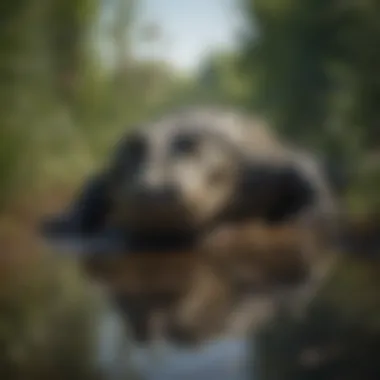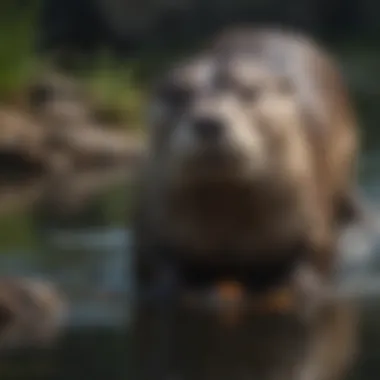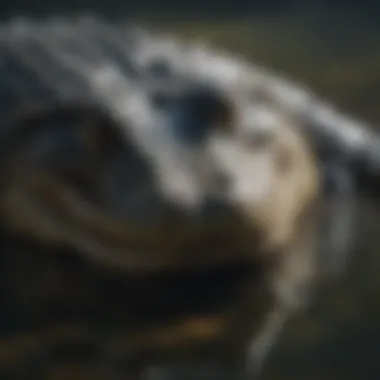Exploring the Enigmatic Realms of Otters and Crocodiles: A Fascinating Dive


Animal Species Profile
Otters and Crocodiles are two fascinating species that inhabit the intricate realms of aquatic ecosystems. Otters, with their sleek bodies and playful demeanor, serve as charismatic ambassadors of nature's whimsy. On the other hand, Crocodiles, with their sharp teeth and stealthy movements, embody the raw power and resilience of wildlife. These animals play distinct roles in their environments, shaping the dynamics of their ecosystems.
Introduction to the Animal Species
Otters belong to the Mustelidae family and are known for their social nature and mischievous playfulness. Their excellent swimming abilities and streamlined bodies make them well-adapted to aquatic life. Crocodiles, on the other hand, are apex predators that have evolved over millions of years to become efficient hunters both in water and on land. Their prehistoric appearance gives them a mystique that stems from their ancient lineage.
Physical Characteristics and Appearance
Otters typically have fur that insulates them from cold water, webbed feet for swimming, and sharp claws for catching prey. Their elongated bodies and tapered tails aid in swift navigation through the water. Crocodiles, on the other hand, have armored skin, powerful jaws, and a streamlined body built for stealth and ambush. Their distinctive V-shaped snouts and menacing gaze add to their intimidating presence.
Natural Habitat and Distribution
Otters are found in a variety of aquatic habitats, such as rivers, lakes, and coastal waters. Their distribution spans across different continents, with some species adapting to both freshwater and marine environments. Crocodiles inhabit tropical areas with ample water sources, such as swamps, rivers, and marshlands. They have a wide distribution in Africa, Asia, the Americas, and Australia.
Behavior and Social Interactions
Otters are highly social animals that form close-knit family groups. They engage in playful activities to bond with each other and sharpen their hunting skills. Crocodiles, on the other hand, are solitary predators that exhibit complex behaviors when hunting or defending their territory. Their communication involves vocalizations, body language, and scent marking to establish dominance and hierarchy.
Introduction to Otters and Crocodiles
In the vast and mysterious realm of wildlife, the enigmatic creatures known as otters and crocodiles hold a unique place. This article embarks on a fascinating journey to unravel the intricacies of these fascinating species. With their distinct characteristics and behaviors, otters and crocodiles fascinate and intrigue both researchers and nature enthusiasts alike. Understanding their importance in the ecosystem sheds light on the delicate balance of nature and the significance of their presence in the wild.
A Brief Overview of Otters
The Different Species of Otters
Otters belong to the subfamily Lutrinae, encompassing 13 species worldwide. From the playful sea otters to the elusive giant otters of South America, each species exhibits unique traits and adaptations. In this article, we delve into the diverse array of otter species, highlighting their specialized habitats and remarkable survival strategies. Exploring the intricacies of each otter species allows us to appreciate the richness of biodiversity that these creatures contribute to the natural world.
Habitats and Distribution


Otters are highly adaptable creatures, inhabiting various aquatic environments across the globe. From freshwater rivers to coastal seas, their distribution reflects their versatile nature. Examining their habitats and distribution patterns provides insights into their evolutionary history and ecological requirements. Understanding the significance of different habitats for otters underscores the importance of conservation efforts in preserving these fragile ecosystems.
Adaptations for Survival
Adapted for an aquatic lifestyle, otters possess a plethora of physical and behavioral adaptations for survival. Their dense fur coats provide insulation in cold waters, while webbed feet aid in efficient swimming. Behavioral adaptations such as cooperative hunting and burrow building showcase their intelligence and social dynamics. By delving into the intricate adaptations of otters, we gain a profound appreciation for their resilience and evolutionary prowess.
Insights into Crocodiles
Diverse Crocodile Species
Crocodiles represent a diverse group of predators with 14 recognized species worldwide. From the formidable Nile crocodile to the diminutive dwarf crocodile, each species exhibits specialized adaptations for survival. Exploring the diversity of crocodile species sheds light on their evolutionary history and ecological roles. Highlighting the characteristics of each crocodile species deepens our understanding of these ancient reptiles' significance in their respective environments.
Physical Characteristics
Characterized by robust bodies, armored scales, and powerful jaws, crocodiles possess formidable physical attributes. Their streamlined bodies enable swift movements in water, while sensory adaptations allow for efficient hunting. Understanding the physical characteristics of crocodiles illuminates their predatory prowess and unmatched abilities as apex predators. Examining the intricate details of their anatomy offers valuable insights into their role in maintaining ecosystem balance
Behavioral Patterns
Crocodiles display a range of complex behaviors, from territorial displays to intricate mating rituals. Their solitary nature and stealthy hunting tactics showcase their adaptation to a predatory lifestyle. By examining the behavioral patterns of crocodiles, we uncover the intricacies of their social interactions and survival strategies. Exploring the behavioral nuances of these ancient reptiles enhances our understanding of their evolutionary success and ecological impact.
Comparative Analysis
In this section, we delve into the fascinating topic of the similarities and differences between otters and crocodiles. By comparing their hunting strategies, social structures, and ecological roles, we gain valuable insights into these enigmatic creatures. Understanding the distinct approaches each species takes in various aspects of their lives allows us to appreciate their unique characteristics and evolutionary adaptations. Through a comparative analysis, we aim to highlight the diversity of behaviors and traits that make otters and crocodiles integral parts of their ecosystems.
Hunting Strategies
Otters' Hunting Techniques
Exploring the hunting techniques of otters unveils a world of skill and precision. These agile mammals employ a variety of tactics, including cooperative hunting and superb underwater agility. Their ability to work together to catch prey showcases their social intelligence and adaptability. Otters' hunting techniques play a crucial role in maintaining aquatic populations' balance and ensuring their own survival. The efficient nature of otters' hunting strategies reflects their evolutionary prowess and specialized adaptations for aquatic life.
Crocodiles' Ambush Tactics
On the other hand, crocodiles rely on patience and stealth in their hunting tactics. With a reputation for ambush predators, crocodiles strategically position themselves near the water's edge, waiting for the opportune moment to strike. Their methodical approach to hunting demonstrates their prowess as apex predators in aquatic habitats. Crocodiles' ambush tactics are a testament to their evolutionary heritage and survival instincts honed over millions of years.


Social Structures
Otters' Playful Communities
Otters' social structure centers around playful communities that foster cooperation and camaraderie. These engaging animals thrive in groups where they can learn from one another, play together, and protect their territory. The playful interactions within otters' communities reflect their emotional intelligence and social bonds, essential for their well-being and survival. The unity and solidarity among otters contribute to their resilience in challenging environments and highlight the significance of social connections in the animal kingdom.
Crocodiles' Solitary Existence
Contrary to otters, crocodiles lead a predominantly solitary existence marked by territorial behavior and limited social interactions. These formidable reptiles prefer solitude, emerging only for mating and establishing dominance. Crocodiles' solitary nature underscores their self-reliance and territorial instincts honed through years of evolution. The solitary existence of crocodiles emphasizes their adaptability and independence in navigating their surroundings and securing resources for survival.
Ecological Significance
In the captivating world of otters and crocodiles, the discussion of Ecological Significance delves into the crucial roles these animals play in maintaining ecosystem balance. Highlighting the interconnectedness of species within their habitats, this section elucidates how otters and crocodiles serve as keystone species, exerting significant influences on their environments. By examining their behaviors, feeding habits, and interactions with other organisms, readers gain insight into the intricate web of life orchestrated by these enigmatic creatures. Through a detailed analysis, this article underscores the importance of understanding and preserving the ecological significance of otters and crocodiles.
Role in Ecosystems
Otters as Keystone Species
Delving deeper into the role of otters as keystone species, it becomes evident that these charismatic animals hold a pivotal position in their ecosystems. Their hunt for prey contributes to regulating populations of various species, thus indirectly influencing the vegetation and overall ecosystem health. The peculiar feeding habits and habitat modifications of otters showcase their integral role in shaping the dynamics of aquatic environments. The resilience and adaptability of otters make them a top candidate for keystone species, as their presence is indicative of ecosystem stability. Despite their small size, otters wield significant ecological influence, making them a focal point in conservation efforts.
Crocodiles' Influence on Aquatic Environments
Conversely, the impact of crocodiles on aquatic environments is profound and multifaceted. As apex predators, crocodiles help in regulating prey populations, preventing overgrazing or unchecked growth that could destabilize the ecosystem. Their nesting behaviors and role in shaping water bodies contribute to biodiversity hotspots in their habitats. Crocodiles' influence extends beyond direct interactions to shaping physical landscapes, creating microhabitats that support various species. The intricate balance maintained by crocodiles underscores their significance in preserving the ecological integrity of aquatic ecosystems.
Conservation Concerns
Threats to Otter Populations
Unveiling the threats faced by otter populations reveals the challenges in safeguarding these captivating creatures. Habitat loss, pollution, and human disturbances pose imminent dangers to otters, disrupting their natural behaviors and survival mechanisms. The vulnerability of otters to anthropogenic activities underscores the urgency of conservation measures. Preserving otter habitats and minimizing human impacts are vital to ensuring their long-term survival in the face of growing environmental pressures.
Challenges Facing Crocodile Conservation
In parallel, the conservation challenges confronting crocodiles highlight the complexities of preserving these apex predators. Human-wildlife conflicts, poaching for skins, and habitat degradation threaten crocodile populations worldwide. Mitigating these challenges requires integrated conservation strategies, engaging local communities, and enacting robust regulatory frameworks. Crocodile conservation efforts must address not only immediate threats but also focus on sustainable long-term solutions to secure the future of these ancient reptiles.


avioral Insights ###.Ot and crocodiles exhibit fascinating behavioral patterns that offer profound insights into their respective worlds. In this section, we delve into the intricacies of their interactions, communications, and reproductive strategies. Understanding these behaviors is crucial for appreciating the ecological roles these animals play in their habitats. Examining otters' playful communities and crocodiles' more solitary existence provides a contrast that enriches our comprehension of their lifestyles, emphasizing the diversity of the animal kingdom and the adaptations they have developed to thrive in their environments..#### Commu on Patterns ###..##### Otte ocal s #####..Otters' vocalizati a key aspect of their communication repertoire, playing a vital role in social cohesion and hunting strategies. Their high-pitched chirps and whistles serve to coordinate group movements and warn of potential dangers. This unique feature of otters' vocalizations enhances their cooperation and ability to survive in challenging terrains, showcasing the significance of sound in their daily activities. Despite being lesser-known, otters' vocalizations are a crucial element in understanding their behavior and ecosystem interactions..##### Crocodiles' Non-verbal Co tion #####..Crocodiles' non-verbal communi is characterized by subtle body language cues, including postures, gestures, and visual displays. This silent form of communication among crocodiles is instrumental in establishing dominance, courtship rituals, and territorial signals. The ability to convey messages without vocalization underscores the evolutionary adaptations of crocodiles and their efficiency in maintaining social hierarchies. This unique feature of crocodiles' communication highlights the complexity of their behaviors and the nuances of interactions within their aquatic environments..#### Reproductive Strategies ###..##### Ott ating Rituals #####..Otters' ng r involve intricate dances, sc king, and vocal exchanges that contribute to pair bonding and reproduction. These rituals are essential for establishing mating pairs, ensuring genetic diversity, and maximizing breeding success. The elaborate courtship displays of otters highlight the importance of communication in their reproductive strategies, showcasing how behavioral cues play a significant role in species survival and propagation. Understanding the nuances of otters' mating rituals provides valuable insights into their social structures and evolutionary adaptations..##### Crocodiles' Nesting Behavior #####..Crocodiles' nesting be revolves around creating intricate t nests, incubating eggs, and guarding hatchlings with maternal care. This nesting process is essential for the survival of crocodile offspring, offering protection from predators and environmental threats. The meticulous construction of nests and maternal instincts displayed by crocodiles underscore the importance of nesting behavior in their reproductive success. By examining the unique features of crocodiles' nesting behavior, we gain a deeper appreciation for their role in sustaining crocodile populations and ensuring species continuity.
Human Interactions
Human interactions play a crucial role in understanding the behavior and significance of otters and crocodiles. By observing how humans interact with these animals, we can gain valuable insights into their ecological impact and conservation efforts. Interaction with humans can affect the behavior and habitat of otters and crocodiles, highlighting the delicate balance needed for coexistence between wildlife and human populations.
Cultural Depictions
Mythological Representations of Otters
The mythological representations of otters offer a unique perspective on these creatures in folklore and legends. Often portrayed as playful and clever beings in various cultures worldwide, otters symbolize agility and quick-wittedness. Their role in myths reflects their adaptability in challenging situations, making them a popular choice for allegorical tales.
Crocodiles in Folklore and Symbolism
Crocodiles hold diverse symbolic meanings in folklore, representing power, ferocity, and patience in different cultural contexts. Known for their survival instincts and ancient lineage, crocodiles symbolize both danger and resilience. Their presence in folklore often conveys messages about strength and endurance, making them a compelling figure in symbolic storytelling.
Conservation Efforts
Community Initiatives for Otter Protection
Community initiatives focused on otter protection emphasize the importance of local involvement in conservation projects. By actively engaging communities in safeguarding otter habitats and promoting education on coexisting with these animals, these initiatives create a sense of ownership and responsibility towards otter conservation.
Conservation Projects for Crocodile Habitats
Conservation projects aimed at preserving crocodile habitats are crucial for ensuring the survival of these apex predators. By implementing strategies to mitigate human-wildlife conflicts and protect critical crocodile habitats, conservation efforts contribute to maintaining the ecological balance and biodiversity of aquatic ecosystems.
Conclusion
Reflections on Otters and Crocodiles
Impact on Ecosystems
Diving into the impact of otters and crocodiles on ecosystems reveals a complex interplay that resonates throughout this article. Otters, as keystone species, play a crucial role in regulating aquatic environments by controlling prey populations and ensuring ecosystem health. Their voracious appetites for fish maintain ecological balance, preventing overpopulation of certain species and promoting biodiversity within rivers and lakes. Crocodiles, on the other hand, shape their habitats through their predatory behavior, acting as apex predators that influence the distribution and abundance of other species. Their presence orchestrates a dynamic equilibrium that reverberates across aquatic ecosystems, highlighting their critical position in the web of life.
Future Prospects for Conservation
Looking ahead to the future of otters and crocodiles, conservation efforts play a pivotal role in safeguarding these enigmatic creatures. As threats continue to mount against their populations, initiatives for habitat protection and species preservation become increasingly vital. The ongoing challenges facing otters, such as habitat destruction and pollution, necessitate proactive conservation measures to ensure their long-term survival. Similarly, crocodiles confront pressures from human activities and climate change, underscoring the urgency of sustainable conservation practices. By elucidating the future prospects for otters and crocodiles in this article, we underscore the importance of collective action in preserving the rich tapestry of life that these animals contribute to.







